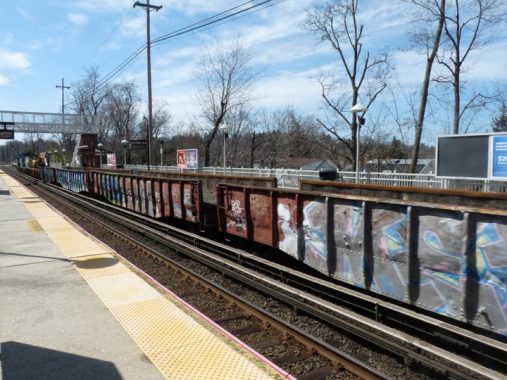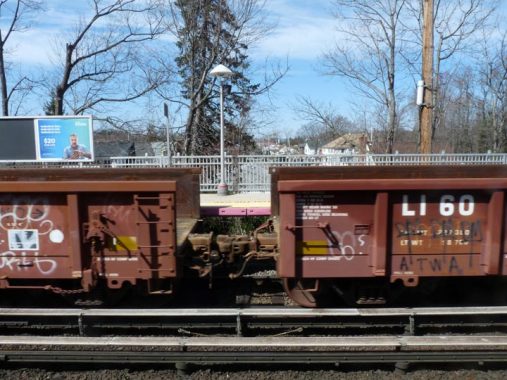
I was out for a “ramble” after a few days of overcast and rain, even though conditions were windy and cold, and was shuffling along the Little Neck LIRR platform. I was fortunate enough to see a work run on what’s ordinarily a passenger line. The LIRR is no stranger to freight, though most of its freight operations are now on the Montauk Branch between Jamaica and LIC, the Bushwick Branch, the Bay Ridge Branch (where subsidiary NY & Atlantic has freight runs) and the main line.
Here LIRR diesel Engines 160 and 165 are pulling a long string of “gondolas” carrying smashed-up rubble. This isn’t a “freight” run, per se, but actually has something to do with ongoing concrete rail tie replacement along the line.


In March 2021 the LIRR reacted to reduced passenger utilization due to the Covid pandemic by slashing service across the board on all lines; on “my” branch, the Port Washington, service was cut from twice an hour to once. At the same time, the railroad has embarked on a rail tie replacement program (the cut in service may have proven fortuitous for that). The Port Washington still mainly uses the wooden ties it has employed for decades, while other branches have received concrete ties; if the PW is going all-concrete, that’d be a welcome shift.
In any case, due to public outcry, full service is supposed to be restored by month’s end.
Has the Port Washington branch ever been used for proper freight runs? Evidence shows that it has; a freight receiving building still stands at the Bayside station. Where is today’s “cargo” going? The Sunnyside Yards (ably chronicled by the Newtown Pentacle); maybe the Oak Point yards in the Bronx. Rail buffs, the Comments floor is yours.
Check out the ForgottenBook, take a look at the gift shop, and as always, “comment…as you see fit.”
3/19/21


15 comments
These aren’t boxcars. They are called gondolas. This is not a freight train, rather a work train as nothing being pulled is making the LIRT any money.
To answer your questions:
The Port Washington branch did have some freight customers years ago. One I definitely remember was just west of the Great Neck Station, Gregory Lumber, a wholesale hardware and building materials business. Just east of Woodside there was a large factory-like building of the General Diaper Service, a firm that vanished with the advent of Pampers. Believe it also a had freight siding, right near the site of the old Elmhurst Station.
The train in the photo is not technically a freight train – it is a work train used for removing debris from railroad construction work. The cars are gondolas, not box cars (which are much taller and are covered).
Freight trains on LIRR tracks are the responsibility of the New York and Atlantic RR, a short haul line that operates freight service in Brooklyn, Queens, Nassau, and Suffolk using LIRR tracks.
The train is no doubt headed for Fresh Pond Yard in Middle Village Queens, where the gondolas will be transferred to the CSX Railroad. The cars will be moved off Long Island to a final disposal location for the rubble (not sure where that might be). What I do know if that the all CSX freight trains leaving Fresh Pond travel across the Hell Gate Bridge to The Bronx and from there to anywhere linked by rail to that location. Oak Point Yards is near the Bronx end of the Hell Gate.
Durkee had a freight siding, tracks were visible until recently.
Yes I remember it now, thanks to your 2009 posting I just found. General Diaper was closer to the old Elmhurst Station site.
Based on what I’ve noticed over the past several years there’s usually a NY&A freight traveling eastbound through through Medford on the Ronkonkoma – Greenport lline around noon on weekdays. It’s probably headed to the Brookhaven Rail Terminal yard in Yaphank, I’m not sure if it’s coming directly out of Fresh Poind or originates at the smaller Pine AIre yard near the Deer Park station. For some reason I’ve very rare seen the westbound runs.
Fresh Pond Queens to Pine Aire. It usually runs at night
Those look like two Electro-motive switchers,model SWI,which were first produced
in 1939 making them antiques in railroad years.
They’re not, they’re MP15ACs. The two units were built in 1977
MP15AC is what the LIRR names their SW1500’s…
Dont forget that where the former Whitestone Brach branched from the PW branch was a major freight hub for many years in addition to where the Stewart line branched from the PW branch right (next to the Home Depot) was also tracks onced used for frieght. Old maps also show coal companies had sightings going into great neck. Passing Cuttermille Road is a Superfund sight directly related to one of the old frieght sidings.
Just east of Bayside, there was siding next to a (now demolished)warehouse. The siding was abandoned but I did locate a picture of several boxcars on the internet. The nearby siding is used for work equipment. Also, in the 70s, the door to the freight building by the Bayside station was open. I helped myself to a handful of old slips/bills from the 40s. One of the was a slip for Tommy guns for the military.
Bayside Lumber yard was located on the eastbound tracks, just slightly past the Bayside Station all during mid 20th century.
On the westbound side, there were sidetracks and sometimes cars of goods. Our parents laid down the law about staying off the side tracks when we went across the (now demolished) pedestrian “bridge” over the tracks to go meet our friends. These were all relics of the street level LIRR station at Bayside. My dad watched them build the (sunken) replacement probably in the thirties.
Burn’s Brothers concrete coal storage silo’s off the Whitestone Branch adj. to Roosevelt ave by Shea Stadium.
Many of these gondolas are very old I believe. I used to regularly take the train from Bethpage to Penn and along the spurs there were often long lines of gondola cars, some of which had the keystone style LIRR logo
Con Edison recieved some type of freight at it’s plant on Lawrence street ( now Collage Pt. Blvd) and there was a toy company warehouse in the same area as the lead to the con-ed property. Also west of Murry street some of the trackside buildings appear to have been served by rail.